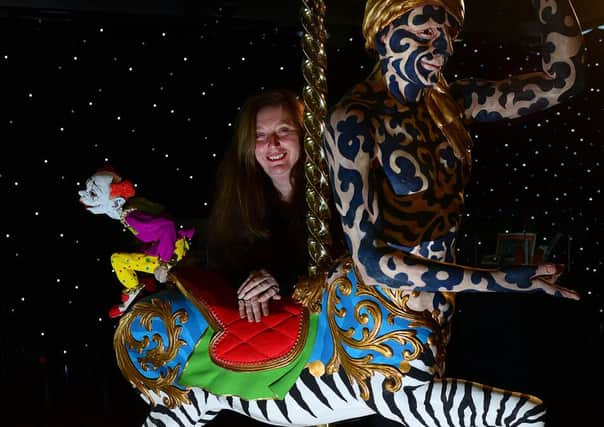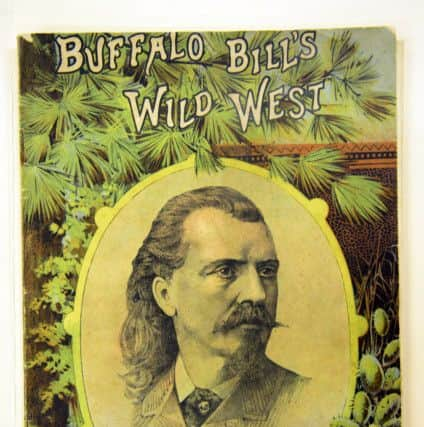Midget show and tell


Professor Vanessa is talking about circus performers juggling children with their feet – what better way to while away these long winter evenings? – when she suddenly breaks off.
“I’ve had some new business cards done; do you like them?” she says, and hands a couple over. Oh yes, very nice, I say, good typeface and they tell you what you need to know: “Professor Vanessa Toulmin, Director of the National Fairground Archive, University of Sheffield”. Turn them over, she says.
Advertisement
Hide AdAdvertisement
Hide AdYou tend not to argue with Professor Vanessa, so I turn one of them over. It’s a photograph of two women, taken a generation ago. They’re on a fairground stall with a couple of dartboards behind them. “My mother and grandmother,” she says. They’re a tribute to her Morecambe background, which taught her to be – as interviews with her generally mention – the only Doctor of Philosophy who can spin candy floss. Probably.


But it’s the other card that raises a surprised eyebrow: a blonde woman in a glittery costume bent double so her chin rests on the floor between her feet. “My Auntie Brenda,” says Toulmin. “A contortionist and dancer at the Moulin Rouge in the 1960s.”
Nothing ever surprises me about Vanessa Toulmin. I’ve known her for more than 20 years, since she founded the archive. She had been all set for a career in archaeology when her Uncle Arthur died. He was a showman, a fairground man, and she realised that his memories had died with him.
So she started to research the history of travelling fairs (she calls them “villages on wheels”), circus, variety, magic, panto, child-juggling and popular entertainment generally. And she began to collect things to house in the newly-founded NFA – which stands not only for National Fairground Archive, but for No Fixed Abode, a term that often crops up on showmen’s birth certificates.
Advertisement
Hide AdAdvertisement
Hide AdNow, as it celebrates its 20th anniversary, the archive boasts about 150,000 photographs, 20,000 items of ephemera (posters, playbills, programmes, tickets), and 4,500 books. It’s internationally important and as big as the residents of Midget City (which we’ll come to) were small. And as it has grown, she says, “a lot of the showmen feel very proud that there’s this archive; it gives them a legitimacy”.
The NFA is marking the anniversary with two exhibitions: Showtime, a selection of eye-catching posters from the archives (on show at Sheffield Children’s Hospital, just across the road) and Marvelosa, a fascinating group show of commissions from half-a-dozen artists inspired by the collection.
There’s a booklet called Two Decades of Delight, packed with colourful, exotic stuff from the vaults. A poster promises the wall-of-death riders Skid Skinner and his wife Dare Devil Alma from Rotherham. A theatre bill features Alan Alan, “The Man You Cannot Hang”, and pianist Tommy “Toes” Jacobsen, the Armless Wonder.
There’s the Great Victorina Troupe (“The limit of the marvellous... Shoots a gun barrel while it is down his throat”) and Togare and his Tigers, and Jeannette’s Cricketing Elephants. Another age, another world, another culture.
Advertisement
Hide AdAdvertisement
Hide AdThe anniversary blockbuster is a lavish “book of treasures” from the archive. A limited edition (200 box sets including other collectables and costing £100 a throw), it’s a collaboration between Toulmin and her university colleague Amanda Bernstein and a reminder that posters and theatre bills that would once have been slapped up one week and pasted over the next can now be cherished.
So, with all that background more or less in mind, we proudly present, before your very eyes, for 500 words only, Professor Vanessa’s Greatest Hits, some of her favourites from the archive. To match the anniversary, of course, it should be a Top 20, but – well, times is hard, so it’s only a Top 10. Here they are, in no particular order but generally making particular sense...
Leoni Clarke’s Clever Cats, a 1891 playbill for an “Extraordinary Troupe of 170 Performing Cats, Rats, Mice, Birds and Rabbits”. The star turn was a parachuting cat and the show also featured Ames – The Flexible Adonis and La Famille Agoust (“French Jugglers on Revolving Globes”).
“It may be the only copy in existence,” says Toulmin. “This material is precious; it’s the life of a performer that’s now lost. I like things you have to research and find. In this world of technology, people think if it’s not on Google it doesn’t exist.” A rare pause. “This material is genetic; it’s in my blood.”
Advertisement
Hide AdAdvertisement
Hide AdMidget City News, a 1934 newspaper published for Midget City, a US community of “little people” set up as what’s now called a visitor attraction. Its “Lilliputian shows” featured, it claimed, the world’s two smallest people, 18in tall Captain Werner Ritter (“You have to look twice to see him”) and 19in Margaret Ann Robinson (“Atomic Adult of Microscopic Minuteness... Get a magnifying glass”). “As a child, I always loved midget shows,” says Toulmin. “I know it’s not politically correct.”
Buffalo Bill’s Wild West, a programme for his 1887 show in England. It featured “wild animals in their native lairs... The friendly dance of two Indian tribes... Attack on the Deadwood Stage”. The programme trumpets how Buffalo Bill – Col WF Cody – killed 4,892 buffalo in one season, 69 of them in one day.
Metempsychosis, a postcard advertising a Victorian “Dyspeptic Illusion” involving 10ft tall dancing prawns strumming lutes. “I suppose I take all this for granted,” says Toulmin, “and don’t realise how weird and wonderful it is.”
Winter Gardens – a 1913 programme for the Blackpool pleasure palace that Toulmin calls “the love of my life”. She helped campaign against its demolition and has worked on the resort’s regeneration. We usually agree to differ about what she sees as the magic and enchantment of Blackpool, but I’m with her when she says: “You can’t turn Blackpool into Brighton.” And it would have been novel to see The Eight Rose Girls and The 12 Forget-me-nots sing Popsy Wopsy.
Advertisement
Hide AdAdvertisement
Hide AdSpace is running out and we still have five of the Top Ten to go. So, a quick portfolio of posters and a modern sculpture:
The Yorkshire Coast for Holidays, a 1955 British Railways poster, with beaming sun-burnished couples; a hint of the Riviera at every turn.
An 1875 Midland railway poster for Cheap Excursions to the Seaside. Sheffield, Rotherham and Barnsley transported to Scarborough, Whitby, Filey and Brid, and transported back, tired and quite possibly emotional.
A 1950s fairground poster with Popeye on the dodgems and a man in a blue pinstripe suit on the coconut shy. “We’ve got posters for a railway excursion to Birmingham Onion Fair,” says Toulmin: a line you don’t often hear.
Advertisement
Hide AdAdvertisement
Hide AdA Chipperfields circus poster (Dickie Chipperfield, the 15-year-old Boy Wonder in the ring with elephants rearing behind him) and – something a bit different and brand-new – one of the commissioned works from the Marvelosa exhibition inspired by the collection... a surreal sculpture by Anthony Bennett based on The Great Omi, who had his body tattooed with black stripes and performed in freak shows, sometimes billed as The Zebra Man.
And finally, a Billy Smart’s Circus poster with people in Davy Crockett (“King of the Wild Frontier”) hats. The Billy Smart Archive was an early NFA acquisition and Toulmin is watching a 1957 film of the circus when I arrive. Plumed women are twirling nonchalantly over the ring... and then the scene changes to clowns climbing unsupported ladders.
“This is earlier footage,” she says. “Definitely 1946 or 1947 – the blue and green stripes on the tent give it away. And that’s Ronnie, Billy’s eldest son.” What’s that dalmatian in the background called, Vanessa? “I don’t know,” she laughs. “I’ve let you down.”
If you’re on the ball, like La Famille Agouste, you’ll have spotted that we’ve actually had Professor Vanessa’s Top Eleven. But what are fairgrounds, circuses and theatres but illusion? Chuck me a couple of kids to juggle.
Advertisement
Hide AdAdvertisement
Hide Ad• The Marvelosa exhibition is at the Exhibition Gallery in the University of Sheffield’s Western Bank Library, until January 8. Showtime is at Sheffield Children’s Hospital’s Long Gallery, on Western Bank, until April 29. Free admission to both. National Fairground Archive. 0114 222 7231, www.sheffield.ac.uk/nfa